
As the railroad industry searches for ways to reduce and ultimately eliminate its greenhouse gas emissions, Wabtec sees hydrogen as the locomotive fuel of the future, whether it’s burned in internal combustion engines or used to power fuel cells.
“We think this is going to be an impactful technology. We’re not seeing this as a fringe thing. This is going to be the thing that replaces diesels in the future,” says Philip Moslener, Wabtec’s corporate vice president for advanced technologies.
Hydrogen produces no greenhouse gas emissions when burned as a fuel. “It is not economically viable today,” Moslener says, noting that hydrogen currently costs significantly more than diesel fuel.
But hydrogen production is expected to rise, which should bring the cost down to rival diesel fuel as early as 2030. In the U.S., the Bipartisan Infrastructure Law includes $7 billion in funding to develop six to 10 hydrogen production and storage hubs, while there are similar efforts under way in Canada. Energy companies, meanwhile, are making investments in hydrogen production facilities.
So Wabtec aims to match its hydrogen locomotive research and development efforts to the planned pace of hydrogen production in North America. Wabtec hopes to field its first hydrogen prototype in 2027.
Fuel Cells and Batteries
Hydrogen-powered fuel cells, combined with batteries to store electricity, would be a zero-emissions solution to replace the diesel-electric locomotive, Moslener says.
But fuel cells don’t yet have the power density required for a line-haul locomotive. A road locomotive would need 3,300 kilowatts of power – or 10 times what’s available from fuel cells that can fit on a locomotive today, Moslener says.
The development of ever more powerful fuel cells is expected to continue, however, much like the way batteries have gained more storage capacity and extended the range of electric vehicles in recent years.
“We will get there,” Moslener says.
If a fuel cell locomotive consist ultimately needs more battery capacity, railroads could always add one of Wabtec’s FLXdrive battery-electric locomotives to the train, he says.
Due to their lower horsepower requirements, fuel cell switching locomotives may become viable sooner than road locomotives.
Road locomotives and switchers will require different energy-management systems because of the different demands of each type of service. Fuel cells prefer producing a consistent amount of power, Moslener says, so switchers would need to draw electricity from batteries rather than tap the fuel cell. Conversely, road locomotives often operate with relatively steady power demands and could tap a combination of the fuel cells and batteries to power their traction motors.
Retrofitting Locomotives to Burn Hydrogen
The other path is burning hydrogen in internal combustion engines. “We also see that as a viable solution, especially one where it’s a transition technology,” Moslener says. “The nice thing about internal combustion engines is it’s engines. We know engines. Customers are comfortable with engines. They know how to maintain them. They know how to operate them.”
Another plus: Wabtec’s Evolution series locomotives can run on hydrogen with little modification. “That’s the nice thing about our EVO family of engines is that they have the capability, the genetics, to be able to be modified to hydrogen,” Moslener says.
The biggest technical hurdle is how to bring hydrogen fuel to the combustion chamber. Like liquified natural gas, hydrogen needs a spark to ignite. The Wabtec LNG-powered locomotives in use on Florida East Coast Railway rely on port injection with diesel fuel used as a pilot. That technology needs to be adapted for hydrogen use, Moslener says.
Hydrogen makes metal brittle over time, which can lead to mechanical failure. To solve this problem, Wabtec is working with the U.S. Department of Energy’s Oak Ridge and Argonne national laboratories. In a project funded by a Department of Energy grant, Argonne is doing computer simulation work, while Oak Ridge is testing a single-cylinder, hydrogen-fueled engine that uses port injection.
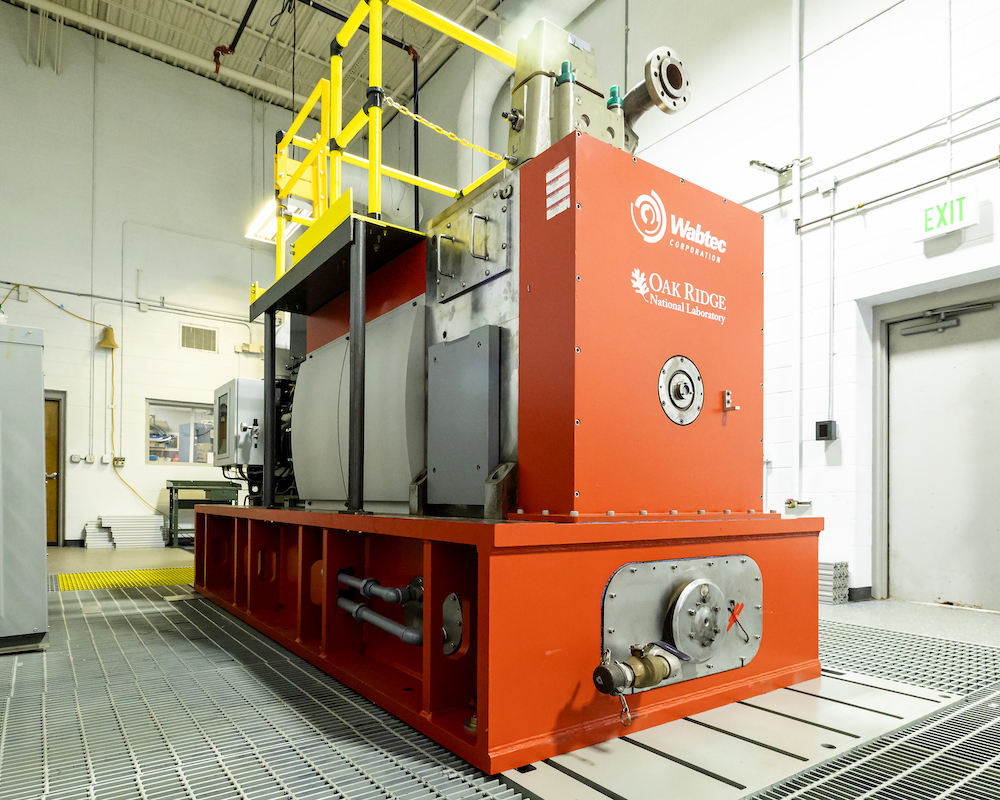
Once the combustion characteristics and ideal fuel mixture are worked out using the single-cylinder engine, tests will shift to a multi-cylinder engine. The next research and development stage would be fielding a prototype hydrogen-powered locomotive.
With port injection, a locomotive could burn a 50/50 mix of hydrogen and diesel fuel. More R&D would be needed to push the fuel mix to 70% hydrogen using a low-pressure direct injection system.
“Obviously we want to push it towards 100% hydrogen,” Moslener says. That would require a leap to high-pressure direct injection, which could enable a 90/10 mix of hydrogen and diesel fuel.
Some diesel is required in order to ignite the hydrogen, so an internal combustion engine would always produce at least some carbon dioxide. “If we want to go to zero emission, we have to go to fuel cell,” Moslener says.
A drawback to burning hydrogen in a traditional internal combustion engine is that nitrogen oxide emissions are not reduced because they’re created during the combustion event, Moslener says. Particulate emissions, however, would fall in line with the reduction in diesel in the fuel mix.
Modifying locomotives would enable railroads to begin reducing their carbon footprint right away by blending hydrogen and diesel, Moslener says.
Hydrogen-powered locomotives would have to be paired with fuel tenders in order to have a range comparable to today’s diesel-electrics. Like FEC’s LNG locomotives, a hydrogen consist would have two locomotives sandwiching a tender. Wabtec dubs these locomotive-tender-locomotive consists “triplets.”
Transition Challenges
Even when hydrogen production scales up, it won’t be available immediately across all 140,000 miles of the rail network. And that will initially create interoperability problems within railroads as well as with interchange service.
The use of internal combustion engines that can be powered by hydrogen or diesel is one way to attack the interoperability problem. An ES44AC or ET44AC with a hydrogen port injection system could run on 100% diesel fuel. Although less efficient, Moslener says this fuel flexibility would help ease the transition from diesel to hydrogen.
The other transition solution is to create hydrogen corridors between terminals that have hydrogen storage and fueling systems. “Customers hate to think about dedicated corridors — but I think we’re going to have to,” Moslener says.
Another mindset change: Thinking about the interaction between triplets, trailing tonnage, and topography rather than just locomotive power.
“We have to start changing that mentality and talk about trains,” Moslener explains, noting that a hydrogen triplet and a battery electric locomotive, combined with energy the locomotives can capture from the train during dynamic braking along particular routes, all will have to be factored into the equation.
One advantage of burning hydrogen directly in internal combustion engines as a bridge to fuel cells is that it will give railroads experience with refueling, safety, training, and hydrogen production, storage, and distribution infrastructure, Moslener says.
Pieces of the Puzzle
A shift to hydrogen power will be complicated. It’s a bit like trying to put together a puzzle without fully knowing what the pieces look like because multiple problems need to be solved along the way.
First, there are five potential hydrogen fuel forms. They include compressing the gas at one of three different pressures; cryo-compression; and liquid hydrogen. Each form requires a different type of storage tank.
Wabtec believes liquid hydrogen is the most logical choice for railroads because it has twice the energy density of compressed hydrogen, Moslener says.
Refueling times also give liquid hydrogen an edge. It would take five or six hours to fill a liquid hydrogen tender today, Moslener says, compared to up to 30 hours for compressed hydrogen. NASA has significantly faster flow rates, he says, and further research and development likely could make liquid hydrogen fueling as fast as refueling a diesel.
“We are thinking the industry needs to go to liquid in the long term, so that’s where we’re putting our R&D efforts,” Moslener says.
But Wabtec can’t go it alone, and investment from railroads and governments will be required.
“There’s a lot of stuff that we need to figure out. Wabtec can’t do it on its own,” Moslener says. “If the industry believes hydrogen is the fuel of the future, then we need to put investments in this to figure out a multitude of issues before it can be a safe, usable fuel.”
ProgressRail, Chevron, and BNSF Railway announced in December 2021 that they are partners in a hydrogen locomotive project. ProgressRail will build a high-horsepower fuel-cell locomotive, Chevron will develop the fueling infrastructure, and BNSF will operate the locomotive as part of a test program.
The supporting infrastructure will be installed next year, with a planned delivery of the unit in 2025, BNSF says. Chevron did not respond to emails seeking additional details.
“Our project to demonstrate a locomotive powered by hydrogen fuel cells is progressing, as we continue our work with Chevron and BNSF to advance hydrogen technology across the rail industry. We see this as an exciting opportunity for carbon reductions from mainline locomotive operations. The collaboration allows us to rapidly improve our understanding of this fuel for the benefit of our customers,” Progress Rail spokeswoman Amy Everett says.
Wabtec is closely following Canadian Pacific Kansas City’s hydrogen fuel cell locomotive project. The hydrogen community is small, particularly in rail, and all of its players encourage and support each other, Moslener says.
Railroads also will have to follow developments and cooperate with other industries. “Rail is a small industry,” Moslener says. “We’re not going to be leading where hydrogen is going. Other industries will be driving the large investments.”
The trucking industry already has some hydrogen fuel cell rigs in revenue service. J.B. Hunt, for example, in July announced the purchase of 13 zero-emissions Class 8 trucks from Nikola, three of which are powered by hydrogen-fuel cells. Nikola’s hydrogen subsidiary, HYLA, is providing the hydrogen and fueling infrastructure. The fuel cell trucks have a 500-mile range.
Hydrogen also will have to overcome a reputation that it’s unsafe. Images of the 1937 Hindenburg airship disaster are still seared into the public consciousness. But hydrogen is safely used in industrial processes across North America today, Moslener notes, and is transported by highway every day without incident.
The railroad industry will, however, have to develop standards around hydrogen production, storage, and fueling, as well as how to detect and handle leaks. If there is a leak, Moslener notes, hydrogen rises and quickly dissipates.
Thanks to a federal grant, Wabtec is working with the Sandia National Laboratory on the development of potential hydrogen standards and regulations for the rail industry.
The Federal Railroad Administration has issued a Net Zero Greenhouse Gas Emissions by 2050 Challenge to the rail industry. Although the agency doesn’t officially back any specific technology to reach zero emissions, the FRA is directly involved in a few industry hydrogen efforts.
FRA is a member of the Association of American Railroads’ Alternative Fuel Tender Technical Advisory Group and participated in Sandia National Lab research on safety and design requirements for a hydrogen tender.
The agency also is involved in the American Public Transportation Association’s efforts to develop a white paper on hydrogen and battery energy storage systems. That paper may lead to a standard and the development of FRA regulations over the long term.
The Hydrogen Rainbow
Hydrogen is the most common element in the universe but is rarely found as a gas on Earth. So it’s produced from compounds that contain hydrogen. Most hydrogen is produced through steam methane reforming, which removes hydrogen from natural gas. It’s also produced through electrolysis, which splits water molecules into two hydrogen atoms and one oxygen atom.
Green hydrogen is produced through electrolysis using power that comes from renewable sources like hydro, wind, and solar power. An offshoot is pink hydrogen, which is produced using nuclear power.
Nearly all of the hydrogen produced in North America today is what’s known as gray hydrogen that comes from steam methane reforming or coal gasification. This hydrogen is considered “dirty” because it’s produced from fossil fuel while also using fossil fuel as an energy source in the production process.
A variation is blue hydrogen, which captures and stores the carbon produced through steam methane reforming or coal gasification.
Why does all this matter? Because the true carbon footprint of any fuel needs to be measured from well to wheel — in other words, the entire production cycle from its source, refining, and distribution to its use as a fuel in a locomotive.
“Our mindset is that we don’t need to wait for green hydrogen to arrive,” Moslener says. “We can start now and benefit from the natural greening of hydrogen as time goes on.”
This progression, he says, would be much like what has happened to battery electric vehicles in recent years. As the electrical grid has become greener as coal-fired generation has declined and wind and solar power have increased, the overall environmental footprint of battery electric cars has improved.
Modal Shift
Moslener says that if you want to decarbonize rail, reduce and ultimately eliminate emissions from locomotives. If you really want to decarbonize transportation, move truckloads to rail. “The real decarbonization play after alternative fuels is modal shift,” he says. “That’s how we’re going to decarbonize North America.”
The transition away from the diesel-electric is likely to cost in the hundreds of millions of dollars when the required infrastructure is included. “It’s going to be very expensive,” Moslener says.
“We’ve got a global crisis on our hands now. To me it’s not about cost,” Moslener says, noting that we are the first generation to feel the impact of climate change yet we are also the last generation that can do something meaningful about it.
“We have a moral obligation to invest in this space now. It will be too late tomorrow. Yes, it will be costly, but we have to bite the bullet and do it now,” Moslener says.
Note: Updated at 9:04 a.m. Central Time on Sept. 11, 2023 with comment from Progress Rail.






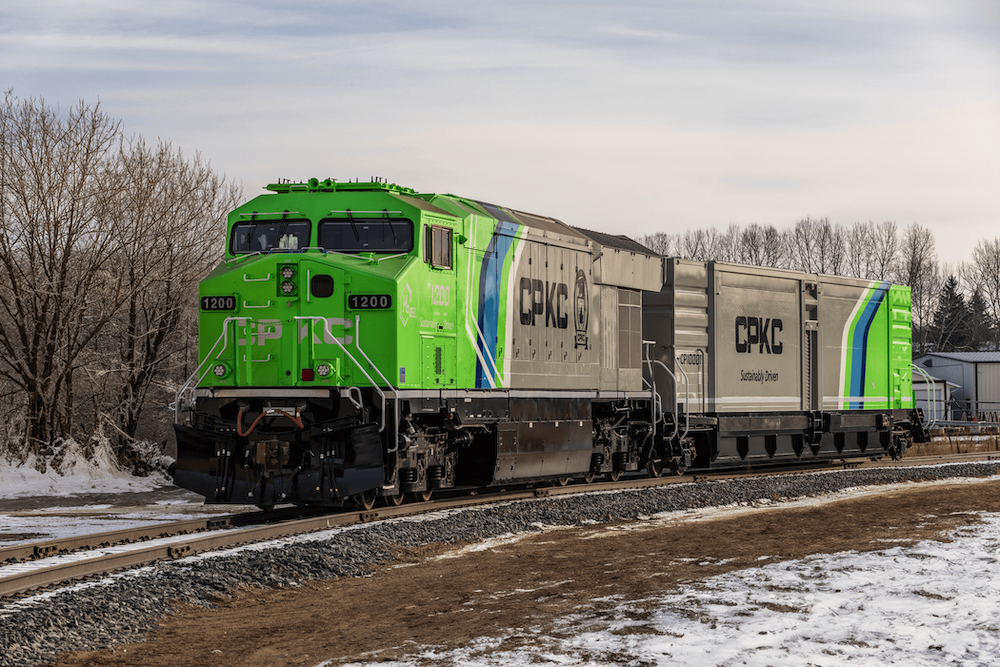
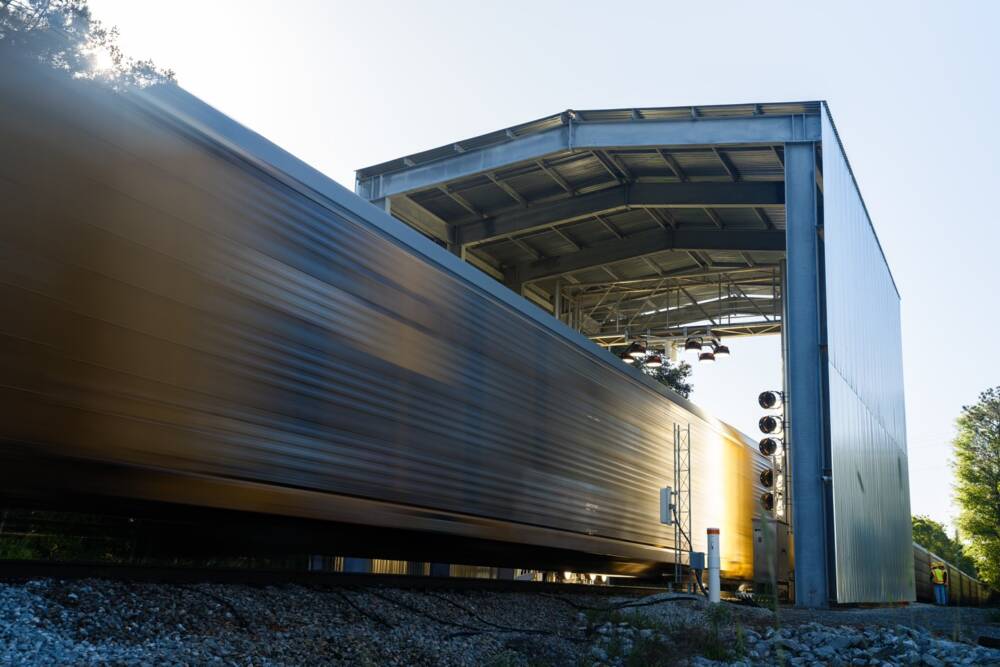
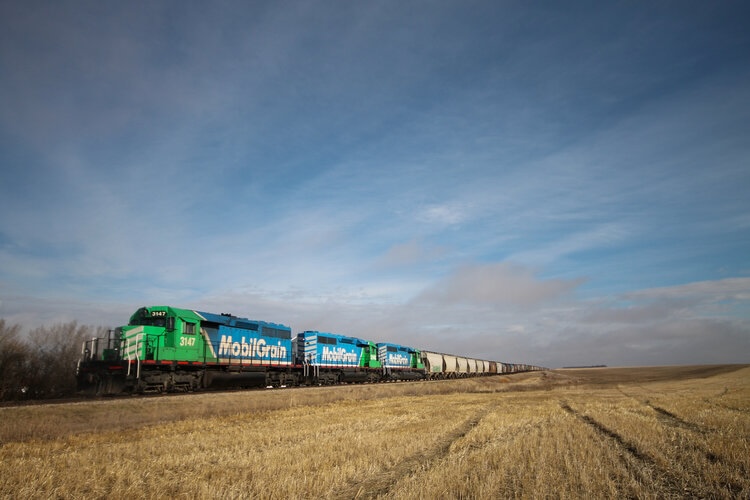

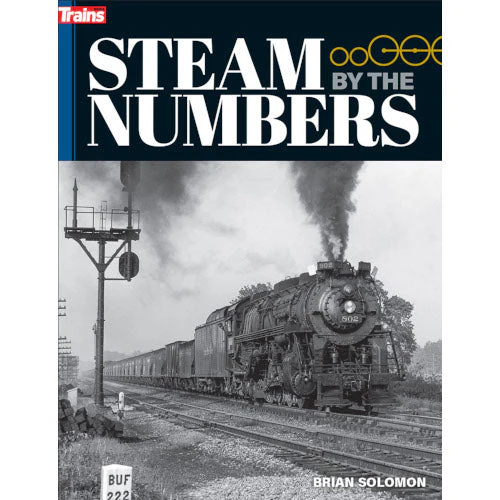


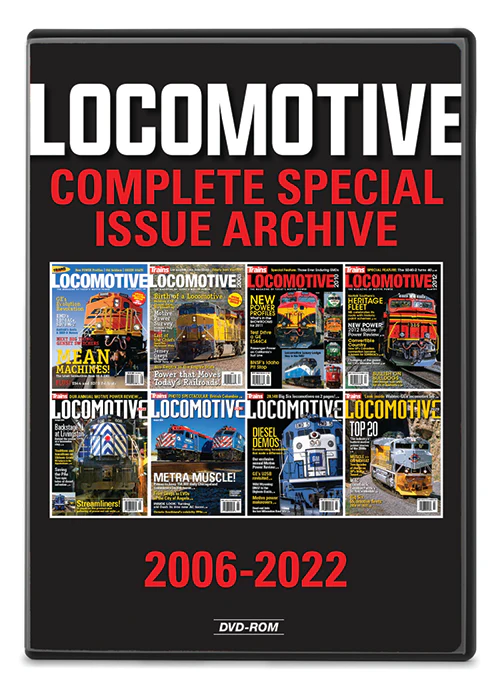
Well, Wabtec wants to sell their stuff. Wabtec has, however, no clue about electric locomotives. And because Wabtec wants to sell something, they have to talk the language of the ones ordering, and that’s not the general public, nor the customers, but the top management (aka wallstreet buttlickers). So, these statements are understandable per se. But it neither helps the environment or the future…
I think I may have discovered why Wabtec is so interested in hydrogen; it can easily be used to formulate ammonia fuel (NH3) that has twice the energy density of plain hydrogen and has NO carbon footprint.
https://interestingengineering.com/innovation/ammonia-for-a-more-sustainable-future
https://www.science.org/content/article/ammonia-renewable-fuel-made-sun-air-and-water-could-power-globe-without-carbon
Electrification is not practical for freight. Its mainly for passenger routes in socialized countries. Yes freight uses this but they are short and the volume is a fraction of what the US system carries. Electrification would eliminate all lower volume branch lines and most industrial spurs. These are all critical pieces to rail keeping freight off the highways. Trains already get 400MPG and can do better with tech so the extremist need to keep their hands out of that just like they need to keep their hands out of our energy policy shutting down viable powerplants that produce clean energy with a low cost. NG and coal flex fuel plants can be very clean if allowed to obtain the permits to rebuild. The sun gets closer to the earth every second…guess we need to find a way to stop that.
With all due respect, but your statement is plain wrong!
Electrification is the way for most efficient railroading. No matter whether passenger or freight. The superiority of an electric engine over any kind of engine carrying its own power source leads to significantly faster trains.
Heavy hauling: one of the heaviest heavy hauler is in South Africa, and their lines are electrified, and operate at amazing low operation cost.
Long-distance freight: Both, the Transsiberian Railway and the Baikal Amur Magistrale in Russia are electrified. And it is not because it is a “socialist country”, but because they know what they are doing, and don’t have wallstreet buttlickers in the management. The same applies for the main lines to the “modern Silk Road” in China.
In a big effort, Indian Railways have brought the electrification rate to 90% within a few years (and this has not been achieved by closing lines…).
And if there are non-electrified branch lines, guess what, there are bi-mode locomotives. An example, specifically designed for freight is the EuroDual 6000, a multisystem unit rated at 6000 kW under wire, but it also contains a diesel engine providing almost 3000 kW (and with that it is comparable to many USAn style diesels…).
I have no idea if Wabtec is on the right path but global warming and climate change is real and finding a path away from fossil fuels is necessary.
You can be assured, they are not on the right path…
Pretty remarkable how a “third-world country” like India is electrifying its 80,000-mile network while America has wasted the last decade arguing which non-yet-scalable technology to eventually adopt, sometimes in the future, maybe, we’ll see…
And to think US railroads had the solution right in front of their eyes the whole time!
India National Railways is only 39,000 miles and is completely run by the government. Seeing that the US rail system is private, they tend to work to find consensus first before making national standards. In a government run system, one decision is made and then the taxpayers pay for implementing it.
State ownership of the railways/trackage throughout Europe in my opinion is how they were able to afford the huge cost to electrify, not private.
My example in Scotland is just that, paid by the taxpayer, total cost of that project was around £750 million by the time bridges were raised and EMU’s from Hitachi were purchased. The DMU’s were transferred to non electrified lines.
GO in Ontario wants to electrify again cost, politics and the trackage is owned generally by CN and CPKC, all hurdles.
I still believe electrification is a good alternative and much more efficient. However, as discussed the cost is extreme and in North America it most likely will never happen continent wide.
Somebody drank the kool-aid.
If having to add DEF supply chains to railroads was dead on arrival to reduce emissions, why would adding a hydrogen supply chain be any different?
If the hydrogen fuel cells only like to run zero or full-throttle, how much inefficiency will be tolerated when a locomotive has to reduce power to stay under the speed limits? Remember why gas-turbines were not an economic success?
That light at the end of the tunnel may be another unfunded mandate…
See it now:
Derailment, fuel cell leak/rupture, spark, BOOM. Half a dozen city blocks gone.
so wabtec has gone woke and fallen for the fake climate change also. sad.
The total amount of energy consumed to move a ton of freight 1 mile is the final metric. To use hydrogen in a locomotive at the energy end to move that 1 ton 1 miles take more energy producing the hydrogen, No mater how you make the hydrogen that energy making hydrogen and then used in locos is more effective using direct electrical generation. Some of the gas turbine recuperative generators are approaching 50 %efficiency.
A bank of Loco prime movers running at a constant speed would be more energy efficient instead of being located in individual locos. Put that output into the CAT wires. Electrial dispatch systems can be very good at balancing demand on any system. Do not forget about regeneration which is not very efficient but is still better than making heat and running cooling fans with dynamic braking,
How much energy is lost in a modern diesel locos that will not be used in any diesel, hydrogen, or fuel cell loco?
The issue is that anything using carbon-based fuel (or fuel involving carbon compounds) is out. Period.
You are right, burning hydrogen in an internal combustion engine is pretty stupid. Compared to an electrified line, you’d need about 5 times the electricity to move your ton of freight for 1 mile when you burn hydrogen in an ICE. That’s a lot of energy wasted! With fuel cells, you are still pretty bad with about 3.5 times…
SOMEONE OUGHT TO GIVE BILL STEPHENS CREDIT FOR THE QUALITY, CLARITY, DEPTH, TIMELINESS AND INTEREST GENERATED BY THIS ARTICLE. WALTER FRITZ, OBER, INDIANA 574-772-4766
@Walter, thought I would let you know your keyboard is broken in case you weren’t aware.
I like that modern engine design. Makes todays engines look like 1970’s Kenworths or Peterbuilt’s.
Isn’t catenary frightfully expensive to install from scratch?
Glasgow to Edinburgh Scotland cost £160 million pounds (204mUS$) for double track about 42 miles in 2016.
Definitely frightening, however they were able to increase passenger train frequency from every 30 minutes to every 15 minutes due to better acceleration and deceleration.
Was the proper solution to their problem, the trains are always packed.
Not really. Using Mr. Salisbury’s figures, the UP’s NOLA to L.A. ex-SP “Sunset Route” would ony cost $10,049,428.57 for catenary. Locomotives, substations, sidings, passing tracks, etc., are all optional at extra cost.
I’m sure UP will step right up with their checkbook.
Not really, if you would let companies doing it (which includes the planning!) who know what they are doing… To be “ready to run”, you should not spend more than $2m per mile of track.
Looking at the UK is pretty bad, because of “anglosphere”…
The PRR 11 kV 25 Hz electrification dates to 1915 Phila-Bryn Mawr and 1918 to Paoli and Chestnut Hill. The NH electrification was older but MTA/MNR pretty much replaced everything with a 60 Hz system.
Amtrak has kicked the can a few times but every time an Acela breaks 135 mph, the can goes through the uprights.
but couldn’t just low emission diesel locomotives work together with hydrogen in addition to biofuels ?
File under — Regulatory Madness
In the name of the environment they’re looking to use 30% more energy burning natural gas ( ng ) to make hydrogen than just using the Ng in a loco.
Why?
Cuz regulations are moving to hyper focusing on the locomotives emissions, not total system emissions.
Pure craziness.
Overhead electrification should be seriously considered, India shows that you can do it with double-stack trains just fine utilizing “high-rise” pantographs on their new “dedicated freight lines” which also see long passenger trains running at about 100-mph with electric locomotives using the high-rise pantograph. For a lot of Amtrak corridors this would make a lot of sense on new dedicated passenger track — like DC-Richmond or LA-SD — using the Airo dual-mode trainsets for where the trains utilize share trackage with freight, if the Class Ones object to wires over their tracks. Hydrogen and/or batteries could replace the diesel prime mover in the dual-modes.
And didn’t Russia (Soviet Union) convert from steam directly to electrification with minimal diesel in the interim.
Hydrogen fuel cells with batteries is niche solution for low density lines and has many hurdles to clear.
Electrification is solid, proven technology and is simpler and more efficient.
Just do it. Starting right now.
While electrification seems obvious, to a Class 1 who is trying to *reduce* headcount, electrification is anathema to cost savings. Maintenance of catenary is labor intensive and unionized.
Look how long they have kicked the can down the road on the Amtrak NE Corridor? Some of that catenary dates back to the 1920’s.
MILW had issues with their catenary during adverse weather in the Cascades. Specifically icing.
I am not saying electrification is not the answer, I am saying its not the golden arrow as being presented here.
Mr. Rice overstates catenary maintenance as an issue. The age of catenary on much of the NEC is testimony to the durability of the investment and in any analysis I’ve seen over the decades, maintenance has not been something that was even mentioned; see for example my article on the New Haven’s electrification in August, 1964 Trains (digital access through Trains.com membership). Power sourcing and balancing of load, and equipment changes needed to use changed current, have been the issues on the NEC, not replacement of catenary. MILW’s problems with icing, very occasional, were due to their low train frequency. In any electrification today low density lines e.g. yard tracks and industry spurs) would be served by battery power, a solution as old as the tri-power locomotives of New York Central and Lackawanna in the 1920’s.
@Jerry Pinkepank: And another issue about icing with the Milwaukee electrification was the low line voltage. At the time they chose 3000 VDC, several (Swiss) alpine lines were electrified with 15 kV/16.7 Hz. This 5 times higher voltage allows the ice layer to be maybe 3 to 5 times thicker before it completely insulates. (and the AC electrification would have had some additional advantages, such as regenerative braking…) It would have required some courage to use the (agreed) new technology over “streetcars on steroids”…
Sounds like some of you should be working for Wabtec, Oak Ridge, Argonne and the like to tell them they don’t have a clue what they’re doing. Just like the same people that said the horse and buggy would never be replaced by the automobile or the whale oil interests saying that electricity was folly.
Sadly, for what ever reasons, these railroad construction engineers, planners, and upper management don’t always see the big picture. Look at how many railroads in history chose to use track gauges other than 4′ 8 1/2″ standard gauge, due in great part to a lack of foresight, awareness, and/or lack of knowledge, but sometimes for national security like Russia and the Soviet Union.
Unfortunately this is perfomative greenwashing by Wabtec, class 1s and the federal government. It seems like a tactic to maintaininternal combustion engines and the associated infrastructure well into the future. For some reason mainline electrification is never discussed by the industry or government. Electrification is the simplest, quickest and most direct way to decrease emissions. It is a proven technology and would also increase capacity.
The electification solution is obvious, ready today and not complicated. Hydrogen is very complicated and is decades off, assuming billions in R&D finds an economic solution that is hardly guaranteed.
AGREED. And we need to further explore the safe(r) use of nuclear liquid thorium fluoride reactors (LFTR) that could be strategically located throughout an electrified railroad.
I would even suggest investigating the possibility of small LFTR power-plants on board traction motor locomotives. And I would even go as far as to suggest the possibility of small LFTR reactors in place of coal and oil fire boxes that heat boilers, in order to further encourage restoring vintage steam locomotives where the tender could be totally dedicated to only hold water with an onboard waste steam distiller. 🙂
One can do an online search by entering as there is much written on the subject.
ABOVE CORRECTION: “One can do an online search by entering [liquid thorium fluoride reactor LFTR], as there is much written on the subject.
Precisely.
Wabtec desperately wants to distract diesel operators from the fact that they could just buy existing electric locomotives from Siemens/Alstrom/etc and not have to fund Wabtec’s dead end development efforts. Everyone outside the oil&gas bubble knows hydrogen is DOA, but the Class Is are in deep denial.
Electrification is the best solution, so uncomplicated and proven.
This was interesting to this layman, and I followed it with an open mind until he got to the last two paragraphs. Here he lost my support, as I mentally went “click” on my on-off switch. I believe this should encourage some contra posts.
Your attitude is going to be the death of people my age and younger. All options should be explored. There are obviously reasons for Wabtec to go this route for looking at future power sources. There is potential demand for when in my future, big business will no longer be able to use existing technology to run trains for one reason or another.